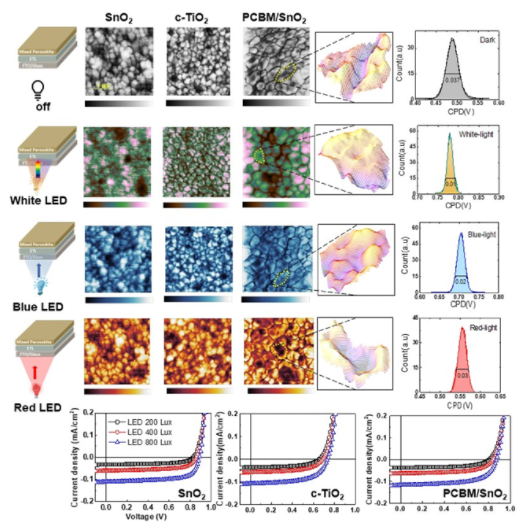- About Ajou
- Admission
- Academics
- Research
-
International
International
- Campus Life
-
News and Event
News and Event
-
AUT
AUT
Ajou News
NEW Prof. Kim Jong-hyun’s Research Team Identifies Principle for Solar Cell Design that Facilitates the Generation of Power
- 2021-11-16
- 2320
A research team at Ajou University, led by Prof. Kim Jong-hyun, has developed a new approach to manufacturing perovskite solar cells that can generate high amounts of power without external sunshine, heralding the entry of solar cells that can use low-intensity indoor lighting instead. This development makes it possible for such lighting to serve as an independent indoor power source for Internet-of-Things (IoT) devices.
Prof. Kim Jong-hyun (Department of Applied Chemistry and Biological Engineering, Graduate School of Molecular Science and Technology) announced that joint research, carried out alongside a research team led by Prof. Jan Seidel and Dr. Jae Sung Yun from Australia’s University of South Wales (UNSW), succeeded in identifying the core design principle of solar cells that can generate highly efficient power using indoor lighting.
The joint research was published in the August 26, 2021 online edition of the international journal Advanced Energy Materials (IF29.3=68, JCR rank: 2.78%) and entitled, “Probing Charge Carrier Properties and Ion Migration Dynamics of Indoor Halide Perovskite PV Devices Using Top- and Bottom-Illumination SPM Studies”. Prof. Kim (right in photo) of Ajou University took part as the corresponding author and Shin So-jeong (left in photo), a student in the Master’s/Doctoral Integrated Program at Ajou University Graduate School of Molecular Science and Technology, as the lead author. Prof. Kim also served as advisor.
Solar cells convert photovoltaic energy into electric energy, and are at the center of attention with the increase in the use of renewable energy. Existing solar cells were generally studied and developed to improve the conversion efficiency of photovoltaic energy into electric energy. With the recent emergence of the 4th Industrial Revolution, however, the demand for indoor IoT electronic devices for smart farms, smart homes, and smart factories, among others, is rising dramatically, and the development of solar cells for indoor application is being highlighted as a power source to enable their operation.
The research team focused on perovskite, which effectively absorbs the light wave band of indoor lights. Perovskite, a hybrid organic/inorganic semi-conductor material with an ABX3 crystal structure, is gaining popularity in solar cells as it makes for highly-efficient energy conversion at low process unit cost. The team also revealed that grain boundary charge traps, which is generated by an interfacial defect in the perovskite layer and the electron transport layer, rapidly lowers the output value of solar cells in an environment with only indoor low-intensity light irradiation. By introducing an electron transport layer able to minimize interfacial defect, the team succeeded in optimizing perovskite solar cell output in an indoor lighting environment.
This research finding is significant as it amounts to a discovery of the core design principle of solar cells that are highly-efficient in converting photovoltaic energy to electric energy in a low-intensity light irradiation environment, and suggests a way to develop solar cells that can produce high voltage energy using indoor lighting.
“Through this research, we revealed the core principle to optimize conversion efficiency of perovskite solar cells in a low-intensity indoor light irradiation environment,” said Prof. Kim. “We are currently conducting R&D on introducing the high voltage perovskite solar cells we developed as the power source for IoT sensors to monitor the health of livestock at an Australian smart farm.”
This research was conducted with grants from the Korea-Australia Strategic International Joint Research Project of the National Research Foundation of Korea (NRF), the Research Facility Establishment Program (Molecular Science and Technology Research Center (MSTRC)), and major programs of the Korea Research Institute of Chemical Technology (KRICT).

<Research results on low-intensity output optimization of perovskite solar cells based on analysis and control of interfacial defects >
